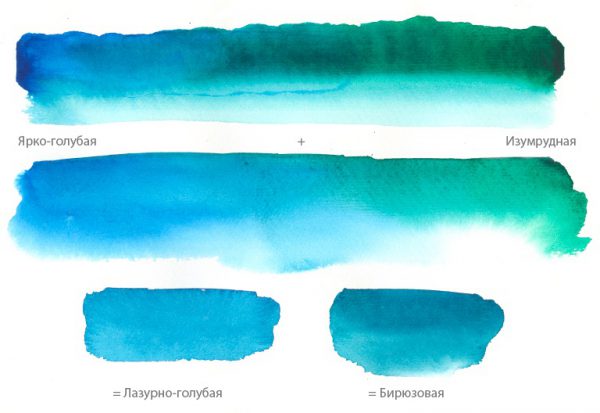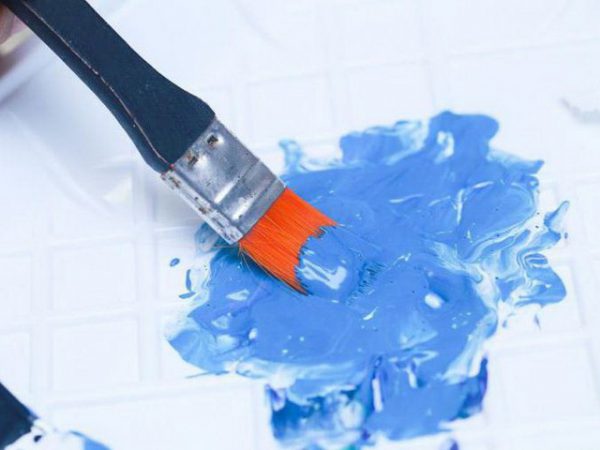Turquoise color can be easily obtained by mixing paints. By definition, turquoise is a shade of blue and green, the color of a sea wave, close to cyan. There are a number of ways how to get a turquoise color, they will depend on the desired result for the artist.
- Turquoise color in nature, its meaning
- Getting a turquoise hue
- Light turquoise
- Dark turquoise
- Aquamarine
- Color ratio table for turquoise

Turquoise color in nature, its meaning
Turquoise is one of the most beautiful shades in the world around it is widespread. This tone can be seen on the sea near resort coasts, turquoise colored water in the area of sea lagoons, various oases and water quarries. Different shades of turquoise are observed in the sky in the early hours of the morning. This color is not present in the main palette, it must be obtained by combining paints.
Psychologists call turquoise cold, mysterious, although in people it is associated with intimate conversations with friends. In the countries of the East, color symbolizes faith, healing, compassion, and in Europe it was formerly considered a talisman that bestows luck.
to contents ↑Alternative medicine uses turquoise in color therapy: this shade is good for the eyes, can strengthen immunity, and reduces the risk of overload, depression and stress. It is believed that this tone is very harmonious, designed to add calmness, poise to a person, helps to control emotions.
Getting a turquoise hue
Making turquoise color with your own hands is easy. To do this, you can use gouache, watercolors, acrylics, you just need to mix them in certain proportions. Since turquoise is called a mixture of green with a drop of blue, then these two basic tones will be required to prepare the paint.
There is no clear instruction on the number of colors. Search is a creative process where the norms of colors are selected individually. For work you need:
- a palette or plate of white color;
- tassels;
- a glass of water;
- paper.
It is necessary to take an amount of greens sufficient for work that does not have any extraneous impurities, and then add blue dropwise. Mix colors It follows after the introduction of each new batch of material. In any case, the amount of blue paint should be less than green. If the color seems appropriate, it should be tried out. To do this, make a smear on the paper - a uniform turquoise tone should remain on it.
There are various shades of turquoise - sea wave, azure, blue-green, as well as exotic for hearing beginners curacao, aquamarine, the color of thrush eggs and others. It is worth considering the manufacturing process of the most popular turquoise halftones in more detail.
to contents ↑Light turquoise
To create a lighter tone, you will need not blue, but blue paint. It is made the simplest method - add a little white to the desired degree of clarification. Then they begin to gradually introduce a blue tone into green, until a delicate turquoise hue “emerges”.Also, professionals often add a drop of yellow paint to the mixture - it gives brightness and lightness to greenery, makes it light green, so the finished turquoise will be airy, very beautiful. If the finished tone does not seem tender enough, it can be diluted with any amount of white paint until a pastel shade is obtained.
to contents ↑When light turquoise still needs to be “cooled”, a little gray paint can be introduced into the finished color. That is, mix green, blue, white and gray tones. The result is an unusual muted color, perfect for drawing pictures of the sky.
Dark turquoise
Dark turquoise tones are easy to do on their own. To do this, you should purchase cyan paint, which already has a green shade of blue (sold in a store for artists). You need to put a little of such paint on the palette, then add the usual green color in small portions. A dark turquoise color is obtained by introducing a small amount of greenery, while thorough mixing is very important. Some experts add a little brown to further darken the tone, this color will be a little warmer than regular turquoise.
to contents ↑Aquamarine
Sea color is obtained in a similar way. It will require two standard colors - blue and green - in approximately equal proportions. They are mixed until homogeneous, after which a tiny amount of white paint is introduced for some clarification. Depending on the amount of white, the color of the sea wave will change from saturated to paler. For professionals, a mixture of blue phthalocyanine and titanium dioxide is called sea color, but ordinary (classic) gouache from the store is quite suitable for the layman.
to contents ↑Color ratio table for turquoise
In the spectrum of primary colors, turquoise cannot be seen; there are only basic tones. But by mechanically mixing the paints you can make almost any desired color. Here is a table with data that will help you navigate the variety of shades of turquoise:
| New color | Connectable colors | Approximate ratio |
|---|---|---|
| Light turquoise | Blue, green, white or cream | 100:5:2 |
| Pale turquoise | Blue, green, white | 100:10:5 |
| Dark turquoise | Cyan green | 100:40 |
| Sea wave | Green, blue, white | 100:50:10 |
Even the schoolchild can make the color under consideration. Experiments will help to create an original color - for this you only need paints, brushes, a palette and a little imagination!








